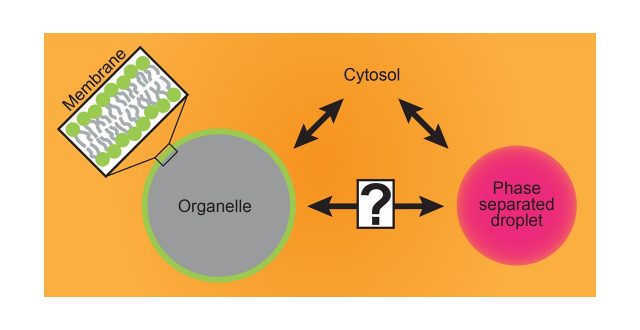Protein-rich droplets, such as stress granules, P-bodies, and the nucleolus, perform diverse and specialized cellular functions. Recent evidence has shown the droplets, which are also known as biomolecular condensates or membrane-less compartments, form by phase separation. Many droplets also contact membrane-bound organelles, thereby functioning in development, intracellular degradation, and organization. These underappreciated interactions have major implications for our fundamental understanding of cells. Starting with a brief introduction to wetting phenomena, we summarize recent progress in the emerging field of droplet–membrane contact. We describe the physical mechanism of droplet–membrane interactions, discuss how these interactions remodel droplets and membranes, and introduce “membrane scaffolding” by liquids as a novel reshaping mechanism, thereby demonstrating that droplet–membrane interactions are elastic wetting phenomena. “Membrane-less” and “membrane-bound” condensates likely represent distinct wetting states that together link phase separation with mechanosensitivity and explain key structures observed during embryogenesis, during autophagy, and at synapses. We therefore contend that droplet wetting on membranes provides a robust and intricate means of intracellular organization.

【総説】細胞内における「濡れ」は膜とタンパク質と液滴の接触によって生理的な機能を様々持つと主張
WRHIからのお知らせ おすすめ
細胞制御工学研究センター Alexander I. May特任助教の国際共著論文
”Intracellular wetting mediates contacts between liquid compartments and membrane-bound organelles”
が、Journal of Cell Biology にオンライン掲載されました。(DOI:10.1083/jcb.202103175 )
この総説では、多くの細胞内現象が物理学の概念である「濡れ」で説明できると主張しています。特に相分離で発生したタンパク質の液滴と様々な膜が接触した際、液滴だけではなく膜も形態や機能が変化することについて議論しています。今まで単独な存在と考えられることの多かった液滴についてさらなる生理的な機能を指摘しています。
詳しくはこちら
<Abstract>
